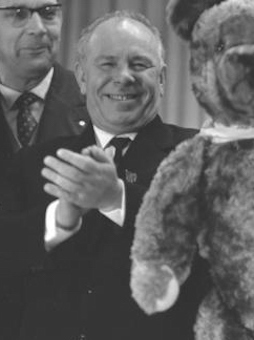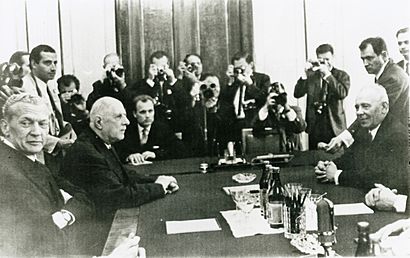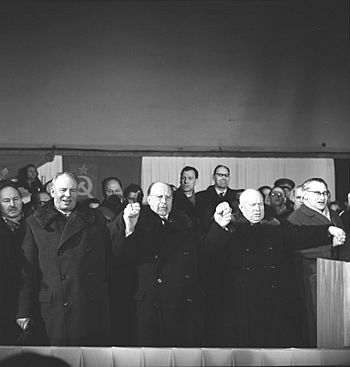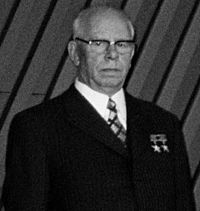Nikolai Podgorny facts for kids
Quick facts for kids
Nikolai Podgorny
|
|
|---|---|
|
Никола́й Подго́рный
|
|

Podgorny in 1963
|
|
| Chairman of the Presidium of the Supreme Soviet of the USSR |
|
| In office 9 December 1965 – 16 June 1977 |
|
| Preceded by | Anastas Mikoyan |
| Succeeded by | Leonid Brezhnev |
| Second Secretary of the Communist Party of the Soviet Union | |
| In office 14 October 1964 – 6 December 1965 |
|
| Preceded by | Leonid Brezhnev |
| Succeeded by | Mikhail Suslov |
| First Secretary of the Communist Party of Ukraine | |
| In office 26 December 1957 – 2 July 1963 |
|
| Preceded by | Alexei Kirichenko |
| Succeeded by | Petro Shelest |
| Personal details | |
| Born | 18 February [O.S. 5 February] 1903 Karlovka, Russian Empire |
| Died | 12 January 1983 (aged 79) Moscow, RSFSR, Soviet Union |
| Nationality | Soviet |
| Political party | Communist Party of the Soviet Union (1930–1982) |
| Spouse | Natalya Nikolayevna Podgornaya (1908–1995) |
| Children | Natalia and Lesia |
| Profession | Mechanical engineer, civil servant |
| Signature | |
|
Central institution membership
1963–1965: Member, 22nd Secretariat
1960–1977: Full member, 20th/21st, 22nd, 23rd, 24th & 25th Politburo 1958–1960: Candidate member, 20th Presidium 1952–1982: Full member, 20th, 21st, 22nd, 23rd, 24th, & 25th Other political offices held
1953–1957: Second Secretary, Communist Party of Ukraine
Jan.–Mar. 1958: Deputy Chairman, Bureau of the Central Committee of the Russian SFSR 1950–1953: First Secretary, Kharkiv Regional Committee of the Communist Party of Ukraine 1944-1946: Deputy People's Commissar of the Food Industry, Council of People's Commissars of the Ukrainian SSR 1942-1944: Director, Moscow Technological Institute of Food Industry 1940–1942: Deputy People's Commissar of the Food Industry, Council of People's Commissars of the USSR 1939–1940: Deputy People's Commissar of the Food Industry, Council of People's Commissars of the Ukrainian SSR |
|
Nikolai Viktorovich Podgorny (born February 18, 1903 – died January 12, 1983) was an important Soviet leader. He served as the head of state of the Soviet Union, called the Chairman of the Presidium of the Supreme Soviet, from 1965 to 1977.
Podgorny was born into a Ukrainian working-class family in the city of Karlovka. He finished a local worker's school in 1926. Later, he completed his education at the Kyiv Technological Institute of Food Industry in 1931. In 1930, Podgorny joined the Communist Party of the Soviet Union. He rose through the ranks by working for the country's planned economy. By 1953, Podgorny became the Second Secretary of the Communist Party of Ukraine. He then served as the First Secretary of the Communist Party of Ukraine from 1957 to 1963.
In October 1964, Podgorny was part of a group that replaced Soviet leader Nikita Khrushchev. A "troika" (a group of three leaders) was formed. It included Podgorny, Premier Alexei Kosygin, and General Secretary Leonid Brezhnev. On December 6, 1965, Podgorny took over from Anastas Mikoyan as Chairman of the Presidium of the Supreme Soviet. After Kosygin's influence weakened around 1968, Podgorny became the second most powerful person after Brezhnev. However, his power slowly decreased as Brezhnev gained more control. By June 1977, Podgorny was removed from his position as Chairman and from the Politburo. After this, he left politics and lived quietly until his death in 1983.
Contents
Nikolai Podgorny's Early Life
Nikolai Viktorovich Podgorny was born on February 18, 1903, in Karlovka, which was part of the Russian Empire. His family was Ukrainian and belonged to the working class. After the Russian Revolution in 1917, Podgorny helped start the Karlovka branch of the Komsomol, a youth organization. He worked as a Secretary for the Komsomol from 1921 to 1923.
Podgorny began working at age 17 in mechanical workshops in Karlovka. In 1926, he finished a local workers' school. In 1930, Podgorny joined the All-Union Communist Party (Bolsheviks), which was the main ruling party of the Soviet Union.
In 1931, Podgorny graduated from the Kyiv Technological Institute of Food Industry. He then started working in the sugar industry. By 1937, he was promoted to deputy chief engineer in Vinnytsia. In 1939, he became the chief engineer of the Kamenetz-Podolsk Oblast sugar trusts. By the end of 1939, Podgorny was the Deputy People's Commissar for Food Industry in the Ukrainian Soviet Socialist Republic (Ukrainian SSR). The next year, he was appointed to the same role for the entire Soviet Union.
Rising in Soviet Leadership (1942–1964)
During World War II, in 1942, Podgorny became the Director of the Moscow Technological Institute of Food Industry. After Ukraine was freed from Nazi Germany, Podgorny helped the Soviet government regain control there. After the war, he returned to his old job as Deputy People's Commissar for Food Industry of the Ukrainian SSR. In 1946, he became a Permanent Representative to the Council of Ministers of the Ukrainian SSR.
In April 1950, Podgorny was made First Secretary of the Kharkiv Regional Committee of the Communist Party of Ukraine (CPU). In 1953, he was promoted to Second Secretary of the Central Committee (CC) of the CPU. From 1957 to 1963, Podgorny was the First Secretary of the CC of the CPU. This was the most powerful position in Ukraine at the time. In this role, Podgorny worked to rebuild and modernize Ukraine's economy, which had been damaged by the war. He focused on increasing industrial and agricultural production and improving people's lives. He also worked on improving the party's organization and training new leaders.
In 1960, Podgorny became a member of the Politburo. This was the highest group that made decisions in the Soviet Union. By 1963, Podgorny was a key figure in the Soviet leadership as a member of the Secretariat of the Communist Party of the Soviet Union (CPSU). He was a close friend and supporter of Soviet leader Nikita Khrushchev. He traveled with Khrushchev to the United Nations headquarters in 1960. Podgorny also served as a Soviet representative to countries like Czechoslovakia, East Germany, Canada, and Yugoslavia. Podgorny's ideas were greatly influenced by Khrushchev. Even under Leonid Brezhnev's rule, Podgorny was considered one of the most open-minded members of the Soviet leadership.
In 1961, Podgorny briefly lost Khrushchev's favor. This happened when he blamed poor corn harvests in Ukraine on "bad weather." Khrushchev, however, claimed the crops had been "stolen." But in 1962, Podgorny reported that agricultural output had increased again. Under his leadership, Ukraine had doubled its grain supply to the state from the previous year. Because of his success in agriculture, some international observers saw Podgorny as a possible future leader after Khrushchev.
According to historian Ilya Zemtsov, Brezhnev started planning to remove Khrushchev when he learned that Khrushchev preferred Podgorny as his successor. During the 1964 effort to remove Khrushchev as First Secretary and Premier, Podgorny and Brezhnev spoke to the Central Committee. They blamed Khrushchev for economic problems and accused him of making decisions without enough thought. Influenced by Brezhnev and his allies, the Politburo members voted to remove Khrushchev from office.
After Khrushchev: The Troika (1964–1977)
Struggling for Power
After Khrushchev was removed, a "collective leadership" was formed. This group was known as a "troika." It was led by Brezhnev as First Secretary, Alexei Kosygin as head of government, and Anastas Mikoyan as head of state.
Before becoming head of state, Podgorny was the party's Second Secretary. He was in charge of the Party's Organization Division. This position gave Podgorny power that could challenge Brezhnev's role as First Secretary. Because of this, Brezhnev teamed up with Alexander Shelepin, the head of the KGB, to oppose both Podgorny and Kosygin.
Brezhnev and his allies constantly challenged Podgorny's position. In February 1965, an article in Ekonomicheskaya Gazeta criticized the Kharkiv Party organization, which Podgorny had led. It also criticized its economic management. By indirectly criticizing Podgorny, the article questioned his abilities as a top leader. Podgorny responded in a 1965 speech in Baku, Azerbaijani Soviet Socialist Republic. He criticized the Soviet leadership's focus on heavy industry. This move, however, upset not just Brezhnev and Shelepin, but also the more traditional members of the leadership. To make things worse for Podgorny, Mikhail Suslov, who had stayed out of the conflict, sided with Brezhnev. Suslov called Podgorny's views "revisionist." Later, in December 1965, Podgorny left his role in the Secretariat. He took Mikoyan's place as Chairman of the Presidium of the Supreme Soviet. According to Ilya Zemstov, leaving the Secretariat meant Podgorny gave up his hope of becoming the First Secretary.
Most Politburo members under Brezhnev were traditional communists. However, Podgorny remained one of the most open-minded members during this period, known as the Era of Stagnation. Other open-minded Politburo members included Kosygin and Andrei Kirilenko. Disagreements within the Soviet leadership in the 1960s made Podgorny more active. He gave several speeches in Moscow and went on many state visits. This increased his public profile compared to Brezhnev and Kosygin. Some people in Soviet society thought Podgorny was trying to replace Kosygin as Premier or even Brezhnev as General Secretary because of his growing presence in the late 1960s.
In 1971, the 24th Party Congress confirmed Brezhnev and Kosygin as the top leaders. But Podgorny still showed he was important in Soviet politics. He led delegations to China and North Vietnam later that year. As Brezhnev became more flexible, Podgorny gained support from traditional communists. He opposed Brezhnev's friendly approach to Yugoslavia, disarmament deals with the West, and pressure on East Germany regarding the Berlin negotiations. In the Politburo, Podgorny had the support of Gennady Voronov and Petro Shelest. Also, when Podgorny and Kosygin agreed on something, Brezhnev would be in the minority and had to follow their decisions. However, this rarely happened because Podgorny and Kosygin often disagreed on policies. In the end, the collective leadership lost its power in the late 1970s when Brezhnev gained almost complete control over the Politburo.
Head of State and Diplomacy

In 1967, just before the Six-Day War, Podgorny gave a false intelligence report to Egyptian Vice President Anwar Sadat. The report claimed that Israeli troops were gathering along the Syrian border. That same year, he talked with Pope Paul VI. This was part of the Pope's efforts to improve relations with communist countries. The talks led to more openness for the Roman Catholic Church in Eastern Europe. In 1971, Podgorny made two state visits: one to the People's Republic of China (PRC) and another to North Vietnam. Kosygin visited Canada, while Brezhnev visited Yugoslavia. Podgorny often visited North Vietnam during the Vietnam War to discuss Soviet-Vietnamese relations. In 1973, Podgorny visited Finland and Mohammed Daoud Khan's Afghanistan.
Brezhnev started trying to remove Podgorny as early as 1970. The main reason was that Brezhnev was third in the Soviet diplomatic protocol, while Podgorny was first. Since September 1970, Brezhnev tried to gather support in the Politburo to remove Podgorny. According to Time magazine, there was talk in Moscow that if Brezhnev couldn't remove Podgorny, he would create a new position called Chairman of the Council of State. This new role would give Brezhnev the top state and party job. However, Brezhnev's supporters could not remove Podgorny from his head of state post at the 1970 Central Committee meeting. Brezhnev only had five votes, while seven other Politburo members were against giving him more power. Removing Podgorny under these conditions would have been seen as breaking the rule of collective leadership.
Later Years in Office
In the early 1970s, Brezhnev actually strengthened Podgorny's position. He did this by giving the Presidium more executive powers, which are powers to carry out laws. As a result, the job of Chairman of the Presidium changed from mostly an honorary title to the second most important job in the USSR. Podgorny was happy with these new powers and didn't see much threat to his position.
However, Brezhnev felt threatened by Podgorny's new authority. He asked Konstantin Chernenko to look at the 1936 Soviet Constitution to find a way to weaken Podgorny's power. It turned out there was no way under the existing Soviet law. As the head of state, Podgorny could block any actions Brezhnev took to limit his powers. Chernenko's solution was to make a new law that allowed the Party leader to also become the Chairman of the Presidium. So, a new constitution was written to include this rule. On October 7, 1977, the 1977 Soviet Constitution was approved. This constitution confirmed the Party's top power in Soviet society. The approval of this new constitution is seen as the end of Podgorny's political career.
Removal from Power
Podgorny's removal from office in 1977 is a famous example of how power changed hands in the late Brezhnev Era. According to Robert Vincent Daniels, Podgorny was the second most powerful person in the Soviet Union before his removal, after Brezhnev but ahead of Premier Kosygin. Even though some experts predicted Podgorny's fall, the decision to remove him from the Politburo surprised the world.
On May 24, 1977, the Central Committee voted unanimously to remove Podgorny from the Politburo after Grigory Romanov suggested it. The vote seemed to surprise Podgorny. Immediately after the vote, he moved from his Politburo seat to sit with the regular members. However, the Central Committee had only voted him off the Politburo. Podgorny still kept his position as Chairman of the Presidium. After his removal from the Politburo, Podgorny's name disappeared from Soviet news. The Soviet media told people that he had retired because he was against improving relations with the West and producing more consumer goods. Podgorny finally lost his Chairmanship of the Presidium on June 16, 1977.
Because of his old age, Brezhnev was considered too old to do some of the duties of the head of state. So, the Supreme Soviet, following Brezhnev's orders, created a new position: First Deputy Chairman of the Presidium of the Supreme Soviet. This job was similar to a Vice President. Vasili Kuznetsov, who was 76 years old, was unanimously approved for this new role by the Supreme Soviet.
Retirement, Death, and Recognition
Not much is known about Podgorny's life after he resigned. The last time he was mentioned in major Soviet news was his meeting with Urho Kekkonen, the President of Finland. The Soviet authorities never gave an official explanation for his removal or criticized him publicly. Podgorny kept his seat in the Supreme Soviet even after his fall from power.
In November 1978, Tokichiro Uomoto, the Japanese Ambassador to the Soviet Union, saw Podgorny at the 61st anniversary celebration of the October Revolution at the Grand Palace of the Kremlin. Podgorny spoke to Brezhnev, Kosygin, and then to Andrei Gromyko. According to Uomoto, all of them looked uncomfortable with Podgorny's presence. Soon after this event, Podgorny lost his seat in the Supreme Soviet. In the Tretyakov Gallery, Podgorny was removed from a 1977 painting of Soviet leaders at Red Square by Dmitriy Nalbandyan. In the original painting, Podgorny stood between Brezhnev and Kosygin.
Nikolai Podgorny died of cancer in Kyiv on January 12, 1983. He was buried in Moscow at the Novodevichy cemetery.
Like many other high-ranking Soviet officials, Podgorny received several awards. He was given five Orders of Lenin, one Order of the Red Banner, and several medals. He also received awards from other countries, including People’s Republic of Bangladesh, the People's Republic of Bulgaria, the Mongolian People's Republic, the Czechoslovak Socialist Republic, and Finland.
Images for kids
See also
 In Spanish: Nikolái Podgorni para niños
In Spanish: Nikolái Podgorni para niños




